From the archeological notebook of Archon Niniri Niri.
Weaponry:
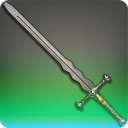
The Flametongue: This sword found within Qarn is fairly standard in its structure, and appears to be a bastard sword, a blade that combines the balance and versatility of a longsword with the heft and length of a greatsword. The name flametongue is an expected one, as Azeyma herself is a deity of flame, and so this blade was likely used by one of her followers, likely a guardian of her temple.
Etymology Notes: Flametongue is a common name for swords that boast a measure of flame magic across fantasy, from the wider Final Fantasy franchise to Dungeons & Dragons.
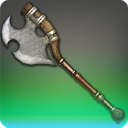
The Boar’s Bane: A common bardiche in structure, these axes were invented by Elezen tribes on Ilsabard during the Sixth Astral Era, but are now a common category of axes with narrow, crescent heads. This weapon was likely used by a notable huntsman or groundsman of Belah’dia, famed for slaying a notable boar.
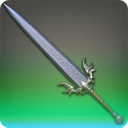
The Platoon Sword: A mighty greatsword of classical design with a double-edged blade tapering from thick to thin from forte to point. The platoon sword was doubtless a weapon of the Sultanate’s military, employed by commanders of its infantry.
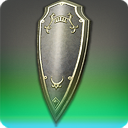
The Qarn Kite Shield: This is a kite shield, a tapered design of shield commonly used by knights of various civilizations and often decorated with heraldry, either that of a house or individual. This likely belonged to an honored warrior of Belah’dia or perhaps a sacred warrior of Azeyma, but whatever insignia it may have once boasted has since faded or hadn’t yet been applied by the time Qarn fell into disuse.
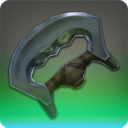
The Fists of the Sixth Sun: Simple fist weapons commonly called knuckles, these are just metal bands that turn a fist strike from stunning to fatal, and are often studded with spikes or barbs. The name borne by these weapons is fascinating, obviously a reference to the Sixth Astral Era in which the civilization of Belah’dia flourished and these weapons would have been used and the sun of Azeyma. Perhaps these were intended to represent a warrior of this new era after the Calamity of Water, bringing the light of Azeyma, and may even represent a predecessor of the pugilists guild.
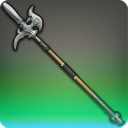
The Shellsplitter: A halberd, part axe and part spear, these weapons allow both slashing and piercing attacks as well as more inventive maneuvers such as tripping or disarming foes with the hooked parts of the polearm. Perhaps this spear was used to slay some of Thanalan’s many fearsome crustaceans and insects during the time of Belah’dia, earning its name.
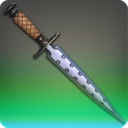
The Banos Del Sol: A common pair of daggers in terms of design, equipped with cutting edges but primarily specialized for a stabbing point. The names of these blades means ‘sunbathing’ according to a linguist archon colleague of mine, again clearly a reference to Azeyma’s role as a sun goddess, perhaps indicating that these blades were bathed in, or consecrated in, her light.
Etymology Notes: Banos del sol translates to sunbathing in Spanish, specifically.
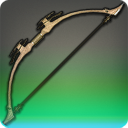
Kokoroon’s Nestpicker: A shortbow, these weapons suit forest-dwellers well due to their slighter size, and are traditionally used by miqo’te tribes. Kokoroon is a qiqirn thief of some note who originally operated on Vylbrand before escaping those hunting him for his crimes by escaping to Thanalan. This bow being found here is evidence that he tried to pilfer the wealth of Qarn before being driven out and forced to leave his bow behind. The nestpicker segment of the name is likely a simple reference to thievery.
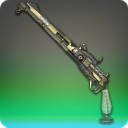
The Hellfire: This is a musketoon, the first kind of firearm that was light enough and had a controllable-enough kickback that it could be wielded in one hand effectively by those who were not freakishly physically strong. They immediately became popular with sailors, and have continued to be to this day. These weapons had been commonplace in Ilsabard even in the early Sixth Astral Era, and although they were and continue to be relatively rare in Eorzea outside of the pirate crews of Limsa Lominsa and, increasingly, the forces of Ishgard, it is entirely possible that one found its way to Belah’dia, perhaps as a gift to the clergy of Azeyma or the Sultan of the region, who would surely see its explosive power as analogous to burning hellfire.
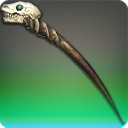
The Anathema: A scepter is a form of thaumaturgy arm created out of a short stock crafted from an organic material such as wood or bone and topped with an elementally charged aether crystal. This allows these arms to be made comparatively cheaply, and thus they are granted often to those new to the discipline. This particular scepter is crafted from some kind of bone or horn and topped by a small beastkin skull, with the essential jewels slotted into its eyes decoratively. An anathema is a curse laid by an organized religion or a target of hatred, and this may well have been used in Qarn to inflict sentences upon those found guilty by the priesthood that ruled over the temple, possibly including curses.
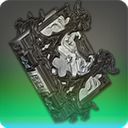
The Pupil’s Book of Silver: A common class of books, the pupil’s books are tomes bound in aetherically conductive metals that have been commonly promoted for their ability to quicken elemental energies, including by numerous instructors within the Studium.
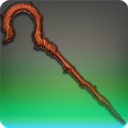
The Bloodcry: Canes such as these are hewn from the roots and branches of dryads, though those taken without permission from the dryad pale in power when compared to those taken with blessing. Similarly, the more twisted a cane the more powerful it is. Dryads are extremely rare in Thanalan, and this weapon may be a relic of Amdapor taken by the Mhachi predecessors of Belah’dia, or if the theory that the city state’s reliance on soulkin proves a link to Amdapor as well as Belah’dia perhaps it was borne by an originator from the white city.
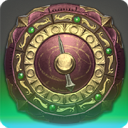
Altair: A standard planisphere, composed of two rotating metal discs which can be used to predict the disposition of the heavens and set with precious stones that represent the six major constellations of Sharlayan astrology. Named for an eagle, this globe likely evoked a similar significance in the stars, although no constellation directly contains a eagle. It likely holds some relationship to the Balance, associated with Azeyma as it is, though I will have to ask my astrologian colleagues the truth of this at a later date. As for how this came to be in Qarn, Sharlayan had not yet settled in Dravania by the fall of Belah’dia, they had nonetheless been extremely active in the Sultanate for the last half-century of its life, constructing a number of aetherytes throughout Thanalan for the Sultanate’s use. It was likely given to Belah’dia by Sharlayan scholars as a token of good will, or brought by them as a means of divining Azeyma’s influence via the Balance.
Etymology Notes: Altair draws its name from an Arabic phrase, roughly meaning ‘the flying eagle’. Arabic culture is of course significant in Belah’dia and Ul’dah. It is also a star in the constellation Aquila, which also represents an eagle.
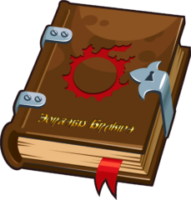



Leave a Reply